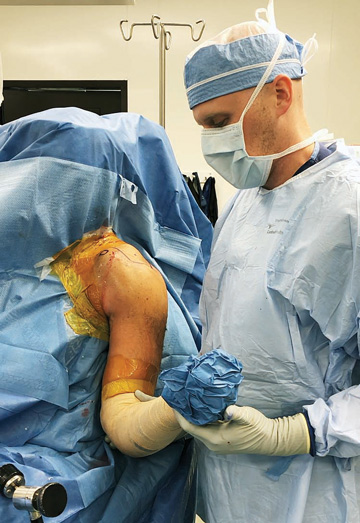Proper patient positioning before shoulder surgery prevents painful nerve and pressure injuries, and gives surgeons critical access to hard-to-reach areas of the joint space. Although surgeons often debate the clinical benefits of the beach chair and lateral decubitus positions, they can agree on the important role positioning plays in their abilities to achieve positive surgical outcomes.
• Beach chair. When placing patients in this position, sit them upright at angles that vary from 30 degrees to 90 degrees above the horizonal plane, with the head secured to the appropriate head rest. Make sure you have the ability to maneuver the upper extremity in a way that will grant proper access to the shoulder joint. “The shoulder blade needs to be off the edge of the bed,” says Edward W. Kelly, MD, MBA, a shoulder, elbow and sports medicine orthopedic surgeon at Twin Cities Orthopedics in Minnesota and Wisconsin. “That provides full mobility of the shoulder during surgery, so you can adduct the elbow to get excellent exposure of the humeral head.”
Dr. Kelly also advises surgeons to focus on how easy it will be to get patients into and out of the position. “I make sure that I can come in and out of the Trendelenburg position smoothly, so I gain exposure to the glenoid as needed,” he says. “I also tilt the patient away from me slightly to help keep them centered on the bed.” Finally, for stability purposes, it’s worthwhile to consider wrapping a co-band or an ACE wrap around the patient’s chest while padding their contralateral arm to keep them secure on the bed, adds Dr. Kelly.
Grant Garrigues, MD, a shoulder specialist at Midwest Orthopaedics at Rush in Chicago, says the beach chair position is a more anatomical position that provides greater visualization of the entire joint. He also points out it’s a setup that requires surgeons to focus closely on posture, padding and stability. “It’s important that the patient is straight on the table, and pressure points are properly padded, comfortable and supported. I also find it helpful to use an articulating arm holder for this purpose.”
• Lateral decubitus. When the patient lies on their side in a non-anatomical position, surgeons are granted better visualization of and access to lateral pathology during procedures. However, you have to be careful to avoid nerve issues around the patient’s armpit — particularly for longer cases. “In the lateral position, the patient’s neck and spine need to be neutral,” says Dr. Garrigues. “You should pad the peroneal nerve and use an axillary roll to protect the nerves in the armpit, because they can experience nerve compressions.”
In addition to keeping patients safe and secure in lateral decubitus, focus on the surgeon’s maneuverability and proximity to the anesthesia provider. “Surgeons must have clear access to the head of the patient’s bed, so they can work in both the front and back of the shoulder,” says Dr. Kelly. “Make sure that the patient is far enough up on the bed and that the anesthesia provider is not in the way.”
.svg?sfvrsn=be606e78_3)

.svg?sfvrsn=56b2f850_5)